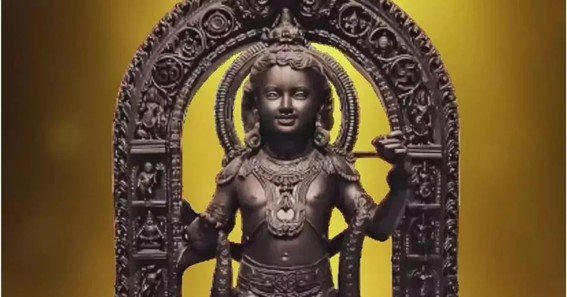The Ram Lalla Murti, representing Lord Rama in his infant form, holds profound significance in Hinduism, symbolizing purity, divinity, and the virtues embodied by Lord Rama. The recent consecration of this sacred idol in Ayodhya’s Ram Mandir marks a pivotal moment in India’s spiritual and cultural history.
Historical Context
The term “Ram Lalla” translates to “Infant Ram,” and the idol has been a central figure in the Ayodhya dispute, which spanned several decades. The Supreme Court of India’s landmark verdict in November 2019 granted the disputed land to deity Ram Lalla, paving the way for the construction of a grand temple in Ayodhya.
Design and Craftsmanship
The newly installed Ram Lalla Murti is meticulously crafted from Shaligram stone, a revered material in Hindu tradition, known for its sanctity and durability. The idol stands at 51 inches, depicting Lord Rama as a five-year-old child, exuding innocence and divinity. The black hue of the Shaligram stone adds to its spiritual significance, symbolizing the eternal nature of the deity.
Consecration Ceremony
The Pran Pratishtha (consecration) ceremony of the Ram Lalla Murti was held on January 22, 2024, in the sanctum sanctorum of the newly constructed Ram Mandir in Ayodhya. The event was graced by dignitaries, including Prime Minister Narendra Modi, who led the rituals, marking a historic moment for devotees worldwide.
Cultural and Spiritual Significance
The installation of the Ram Lalla Murti in Ayodhya is not merely a religious event but a cultural renaissance, rekindling the rich heritage associated with Lord Rama. It serves as a symbol of unity, devotion, and the timeless values that Lord Rama represents.
FAQ
- What is the Ram Lalla Murti?
- The Ram Lalla Murti is an idol depicting Lord Rama in his infant form, symbolizing purity and divinity in Hinduism.
- Why is the Ram Lalla Murti made of black stone?
- The idol is crafted from Shaligram stone, which is traditionally black and holds significant religious importance in Hindu culture.
- When was the Ram Lalla Murti consecrated in Ayodhya?
- The consecration ceremony took place on January 22, 2024, in the newly constructed Ram Mandir.
- Who attended the consecration ceremony of the Ram Lalla Murti?
- The ceremony was attended by several dignitaries, including Prime Minister Narendra Modi, who led the rituals.
- What is the significance of the Ram Lalla Murti in Hinduism?
- The idol represents Lord Rama’s infant form and is a symbol of purity, divinity, and the virtues that Lord Rama embodies.
Conclusion
The consecration of the Ram Lalla Murti in Ayodhya’s Ram Mandir is a momentous event, reflecting the deep-rooted spiritual and cultural ethos of India. It stands as a testament to the enduring legacy of Lord Rama and the unwavering devotion of millions of followers worldwide.










